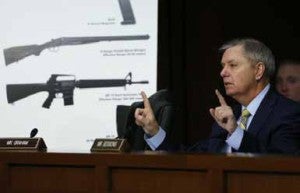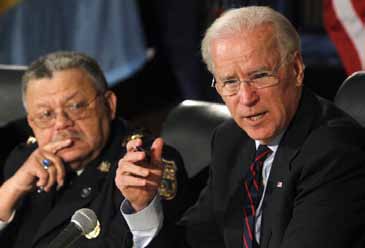[ Spring 2013 ]
Gun violence is one of the most politically divisive issues in the United States–and this contentiousness has played out in government funding of research. In 1993, a study supported by the U.S. Centers for Disease Control and Prevention (CDC) found that, rather than conferring protection, keeping a gun in the house raises the risk nearly threefold of being shot by a family member or intimate acquaintance.
Enraged by what it has called an “almost vicious sentiment against personal firearms ownership,” the National Rifle Association in 1996 successfully lobbied Congress to insert this restriction into the CDC budget: “None of the funds made available … may be used to advocate or promote gun control.” It was a pointed prohibition that went far beyond the rule that federal research money cannot be used for lobbying on any issue. The restriction, which was interpreted broadly by CDC, served as a virtual ban on firearms research. Since the mid-1990s, the agency’s gun safety research budget has dropped by 96 percent.
In 2011, the NRA’s official website offered a rationale for its efforts to stifle research: “These junk science studies … are designed to provide ammunition for the gun control lobby by advancing the false notion that legal gun ownership is a danger to the public health instead of an inalienable right.”
Trusting the messenger
But according to Matthew Miller, associate director of the Harvard Injury Control Research Center (HICRC), “The public health message is neither anti-gun nor pro-gun. It’s pro-data. A public health approach doesn’t look so much to blame as to understand and prevent.”
“Like older white men, people with mental health problems, people with family histories of suicide, etc., gun owners are ‘our’ people,” adds the HICRC’s Catherine Barber, referring to groups with increased suicide risk. “We can’t reach them with an anti-gun agenda. That’s like sending an anti-gay group to do a suicide prevention campaign in the gay and lesbian community. If you don’t trust the messenger, you don’t trust the message.”
The Newtown, Connecticut, massacre, in which the young gunman, Adam Lanza, ended his own life after the elementary school rampage, opened another public health line of argument: that preventing suicides may also prevent homicides, including the relatively tiny number of mass murders. “Mass homicide is an outrageously hostile acting out,” says Miller, “and one can only imagine that it is deeply connected with a hostility directed at oneself as well.”
Yet for Barber, the public health conversation around guns is actually trickier since Newtown, because political positions have grown more entrenched. Toiling for years on the knotty problem of gun suicide has changed her perspective on gun control. “I’m more aware of the cultural divide between gun owners and non-gun-owners, especially when they become politicized and think ill of one another,” she says. “Some gun owners think guns make their family safer. A lot of the guys, they love the mechanism in guns–it’s the same as the love for fine woodworking tools. There can also be cultural connections, where they learned to shoot from their dad or their uncle. Gun owners and non-gun-owners are both caring, but they view the world differently.”
Could new laws prevent gun suicide?
 The current political debate swirls around universal background checks and assault weapons bans and magazine limits–policies unlikely to have a measurable impact on suicide. Deborah Azrael, associate director of the Harvard Youth Violence Prevention Center, is heartened by a less-trumpeted 1999 Connecticut law, which provides a mechanism for people to contact police when they fear a gun will be used for harm.
The current political debate swirls around universal background checks and assault weapons bans and magazine limits–policies unlikely to have a measurable impact on suicide. Deborah Azrael, associate director of the Harvard Youth Violence Prevention Center, is heartened by a less-trumpeted 1999 Connecticut law, which provides a mechanism for people to contact police when they fear a gun will be used for harm.
Police and prosecutors may obtain warrants to seize firearms from people who appear to be an imminent danger to themselves or others. The individual whose guns are taken has the right to a hearing within two weeks. “There have been hundreds and hundreds of people who have been motivated to call the police since the law was put into effect in the late 1990s,” says Azrael. “And they’re not saying, ‘I think my husband is going to kill me.’ They’re saying, ‘I think my husband is going to kill himself.'”
“The courage of our convictions”
Azrael worries that in the revived debate on gun violence, suicide will be eclipsed. She also laments that public health researchers are often reluctant to spin out the implications of the scientific evidence about firearms, for fear of being accused of an anti-gun bias. “It’s a constraint that most researchers don’t operate under. People who do research on lung cancer are allowed to draw conclusions about smoking. The same with people who do research on environmental exposure to PCBs, or on motor vehicle design issues, or on drug overdoses. There’s no national organization pillorying them or actively seeking to defund them.”
In other words, the frank and open conversation about guns that Americans need to have among themselves also applies to researchers who want to share their findings with the public. As Azrael sees it, “We need to have the courage of our convictions.”
Part 1: Guns & Suicide: The Hidden Toll
Part 2: Starting a Conversation
Survivor Profiles
“He was struggling with nightmares.”
“I couldn’t tell people that my father had died of suicide.”
“A club I never wanted to join.”
Download a PDF of Politics & beyond here.
